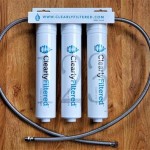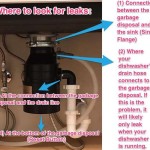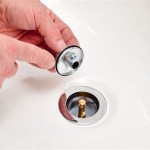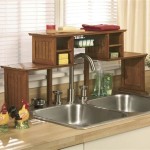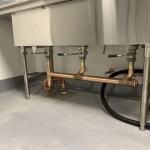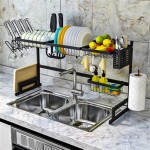How To Make Your Bathroom Sink Smell Better
A persistent unpleasant odor emanating from the bathroom sink is a common household issue. This problem is often caused by the accumulation of hair, soap scum, food particles (in bathrooms adjacent to kitchens), and other debris within the drainpipe. Over time, these substances decompose, producing foul-smelling gases. Addressing this issue promptly is crucial, not only for maintaining cleanliness but also for ensuring a healthy living environment. This article outlines various methods for effectively eliminating bathroom sink odors and preventing their recurrence.
Identifying the Source of the Odor
Before attempting any cleaning solutions, it is essential to pinpoint the exact source of the smell. While the drain is the most probable culprit, other potential sources should be considered. Inspect the area around the sink, including the countertop, the faucet base, and any nearby storage areas. Mold or mildew growth can occur in damp environments, contributing to musty smells. Check under the sink for any spills or leaks that might be harboring bacteria. Furthermore, examine the overflow drain, a small hole typically located near the top of the sink bowl. This area can trap stagnant water and debris, leading to unpleasant odors.
If the odor seems to be concentrated around the drain, the problem likely lies within the drainpipe. In this case, the following steps can be taken to confirm this diagnosis. First, run water down the drain for a few minutes. If the smell intensifies, it strengthens the likelihood that the drain is the source. Next, carefully observe the area around the drain opening for any visible signs of debris buildup. This can provide further confirmation of the problem.
Cleaning the Drain with Natural Solutions
Many effective methods for neutralizing bathroom sink odors utilize readily available household ingredients. These solutions offer a safer and more environmentally friendly alternative to harsh chemical drain cleaners. Baking soda and vinegar is a particularly potent combination, creating a natural chemical reaction that helps to break down organic matter and disinfect the drainpipe.
The process involves first pouring approximately one cup of baking soda down the drain. Follow this with one cup of white vinegar. The mixture will immediately start to fizz and bubble. Allow this reaction to occur for about 30 minutes, during which time the baking soda and vinegar work to loosen and dissolve the accumulated debris. After 30 minutes, flush the drain with hot water for several minutes to clear away the loosened material. This process can be repeated as needed to achieve the desired result.
Boiling water is another simple yet effective method for removing debris from the drain. Carefully pour a kettle or pot of boiling water down the drain. The hot water helps to melt away grease and dislodge any remaining buildup. Exercise caution when handling boiling water to avoid burns.
Lemon juice, known for its antibacterial and deodorizing properties, can also be used to freshen up the drain. Pour about half a cup of lemon juice down the drain and let it sit for approximately 30 minutes before flushing with water. This will help to neutralize odors and leave a fresh, clean scent.
For a more abrasive cleaning action, consider using a mixture of baking soda and salt. Combine equal parts of baking soda and salt (about half a cup of each) and pour the mixture down the drain. Let it sit for a few hours or overnight before flushing with hot water. The salt acts as a mild abrasive, helping to scrub away debris from the drainpipe walls.
It's important to remember that these natural solutions may not be effective for severe clogs or deeply ingrained odors. In such cases, more intensive cleaning methods may be required.
Dismantling and Cleaning the P-Trap
The P-trap, the curved section of pipe located beneath the sink, is designed to trap water and prevent sewer gases from entering the bathroom. However, it can also accumulate significant amounts of debris over time, becoming a major source of foul odors. Cleaning the P-trap involves dismantling it and manually removing any accumulated material.
Before beginning, place a bucket or basin under the P-trap to catch any water that may be trapped inside. Loosen the slip nuts that connect the P-trap to the drainpipe and the tailpiece (the pipe that extends down from the sink drain). These nuts are typically tightened by hand, but pliers may be needed if they are particularly stubborn. Once the nuts are loosened, carefully remove the P-trap. Be prepared for a small amount of water to spill out.
Inspect the inside of the P-trap for any accumulated debris. Use a small brush, such as an old toothbrush or bottle brush, to scrub the inside of the P-trap and remove any clinging material. Flush the P-trap with water to ensure all debris is removed. Similarly, inspect the tailpiece and the section of drainpipe that the P-trap connects to, and remove any visible debris. Once all components are clean, reassemble the P-trap, ensuring that the slip nuts are tightened securely. Run water down the drain to check for leaks. If any leaks are detected, tighten the slip nuts further until the leaks stop.
This process should be performed with caution, as improper reassembly can lead to leaks. If unsure about any of the steps, it is recommended to consult a plumbing professional.
Addressing the Overflow Drain
As mentioned earlier, the overflow drain can be a hidden source of unpleasant odors. This small opening near the top of the sink bowl is designed to prevent the sink from overflowing. However, it can also trap stagnant water and debris, leading to bacterial growth and foul smells.
Cleaning the overflow drain requires a slightly different approach than cleaning the main drain. Since it is not directly accessible, a flexible tube or pipe cleaner is needed to reach inside. A turkey baster or syringe can also be used to flush the overflow drain with cleaning solutions. Start by inserting the tube or pipe cleaner into the overflow drain and gently scrub the inside walls to loosen any accumulated debris. Then, use the turkey baster or syringe to flush the overflow drain with a solution of equal parts water and bleach or vinegar. Let the solution sit for about 15-20 minutes to disinfect the area. Finally, flush the overflow drain with water to rinse away the cleaning solution and any loosened debris.
Alternatively, a specialized overflow drain cleaning tool can be purchased from most hardware stores. These tools are designed to effectively clean and disinfect the overflow drain without the need for dismantling any plumbing components.
Preventative Measures for Maintaining a Fresh-Smelling Sink
Once the bathroom sink odor has been eliminated, it is crucial to implement preventative measures to prevent its recurrence. Regular cleaning and maintenance are key to keeping the drain and surrounding areas fresh and odor-free.
One simple preventative measure is to periodically flush the drain with hot water. Running hot water down the drain for a few minutes each week helps to melt away grease and prevent the buildup of debris. Avoid pouring excessive amounts of grease or oily substances down the drain, as these can solidify and contribute to blockages and odors. Instead, dispose of grease properly in a sealed container.
Using a drain strainer or mesh screen in the sink can also help to prevent hair, food particles, and other debris from entering the drainpipe. Clean the strainer regularly to remove any accumulated material. Consider using enzymatic drain cleaners periodically to break down organic matter and prevent buildup. These cleaners are generally safer and more environmentally friendly than harsh chemical drain cleaners.
Regularly clean the sink basin and surrounding areas to prevent mold and mildew growth. Use a disinfectant cleaner to wipe down the countertop, faucet, and sink bowl. Ensure proper ventilation in the bathroom to reduce moisture levels, which can contribute to mold and mildew growth. Run the vent fan during and after showers or baths to remove excess humidity.
By implementing these preventative measures, it is possible to maintain a fresh-smelling bathroom sink and avoid the recurrence of unpleasant odors.
When to Call a Professional Plumber
While the methods described above are effective for addressing most common bathroom sink odor problems, there are instances where professional plumbing assistance may be required. If the odor persists despite repeated cleaning attempts, or if there are signs of more serious plumbing issues, such as slow drainage or gurgling sounds, it is advisable to consult a qualified plumber.
A plumber can diagnose the root cause of the problem and recommend the appropriate solution, which may involve using specialized tools and techniques to clear stubborn clogs or repair damaged drainpipes. In some cases, the odor may be caused by a more complex plumbing issue, such as a problem with the sewer line or a blocked vent pipe. These issues require professional expertise to resolve.
Furthermore, attempting to fix complex plumbing problems without the necessary knowledge and skills can potentially lead to further damage and costly repairs. Therefore, when in doubt, it is always best to seek the assistance of a qualified plumber.

How To Make Your Bathroom Smell Good 10 Genius S Get The Stink Out Bright Side
:strip_icc()/DesireeBurnsInteriors-faf22b15a1df4b8aae0bcf6c98ded97e.jpg?strip=all)
How To Make Your Bathroom Smell Good

How To Clean A Stinky Sink Drain By Home Repair Tutor Youtube

How To Make Your Bathroom Smell Good 10 Genius S Get The Stink Out Bright Side

How To Make Your Bathroom Smell Good All The Time 5 Best Ways What Mommy Does

How To Make A Bathroom Smell Like Spa
:max_bytes(150000):strip_icc()/__opt__aboutcom__coeus__resources__content_migration__mnn__images__2018__08__sink_drain-351af8e441034f319fe07f00c091d8b6.jpg?strip=all)
How To Clean A Smelly Drain Naturally

One Quick Trick To Keep Your Bathroom Smelling Fresh The Pinning Mama

How To Get Rid Of Sink Smell Benjamin Franklin Plumbing

How To Get Rid Of Smells In A Sink With Or Without Garbage Disposal
